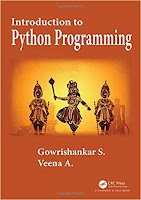Python Projects for Beginners: A Ten-Week Bootcamp Approach to Python Programming
Connor P. Milliken ... 332 pages - Publisher: Apress; (November, 2019) ... Language: English - ASIN: B081LWB7FK by Amazon.
Immerse yourself in learning Python and introductory data analytics with this book’s project-based approach. Through the structure of a ten-week coding bootcamp course, you’ll learn key concepts and gain hands-on experience through weekly projects. Each chapter in this book is presented as a full week of topics, with Monday through Thursday covering specific concepts, leading up to Friday, when you are challenged to create a project using the skills learned throughout the week. Topics include Python basics and essential intermediate concepts such as list comprehension, generators and iterators, understanding algorithmic complexity, and data analysis with pandas. From beginning to end, this book builds up your abilities through exercises and challenges, culminating in your solid understanding of Python.
Challenge yourself with the intensity of a coding bootcamp experience or learn at your own pace. With this hands-on learning approach, you will gain the skills you need to jumpstart a new career in programming or further your current one as a software developer.
Immerse yourself in learning Python and introductory data analytics with this book’s project-based approach. Through the structure of a ten-week coding bootcamp course, you’ll learn key concepts and gain hands-on experience through weekly projects. Each chapter in this book is presented as a full week of topics, with Monday through Thursday covering specific concepts, leading up to Friday, when you are challenged to create a project using the skills learned throughout the week. Topics include Python basics and essential intermediate concepts such as list comprehension, generators and iterators, understanding algorithmic complexity, and data analysis with pandas. From beginning to end, this book builds up your abilities through exercises and challenges, culminating in your solid understanding of Python.
Challenge yourself with the intensity of a coding bootcamp experience or learn at your own pace. With this hands-on learning approach, you will gain the skills you need to jumpstart a new career in programming or further your current one as a software developer.
What You Will Learn: Understand beginning and more advanced concepts of the Python language + Be introduced to data analysis using pandas, the Python Data Analysis library + Walk through the process of interviewing and answering technical questions + Create real-world applications with the Python language + Learn how to use Anaconda, Jupyter Notebooks, and the Python Shell. Who This Book Is For: Those trying to jumpstart a new career into programming, and those already in the software development industry and would like to learn Python programming.



















